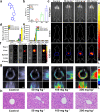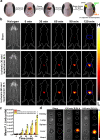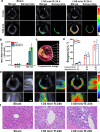A H2O2-activatable nanoprobe for diagnosing interstitial cystitis and liver ischemia-reperfusion injury via multispectral optoacoustic tomography and NIR-II fluorescent imaging
- PMID: 34824274
- PMCID: PMC8617030
- DOI: 10.1038/s41467-021-27233-4
A H2O2-activatable nanoprobe for diagnosing interstitial cystitis and liver ischemia-reperfusion injury via multispectral optoacoustic tomography and NIR-II fluorescent imaging
Abstract
Developing high-quality NIR-II fluorophores (emission in 1000-1700 nm) for in vivo imaging is of great significance. Benzothiadiazole-core fluorophores are an important class of NIR-II dyes, yet ongoing limitations such as aggregation-caused quenching in aqueous milieu and non-activatable response are still major obstacles for their biological applications. Here, we devise an activatable nanoprobe to address these limitations. A molecular probe named BTPE-NO2 is synthesized by linking a benzothiadiazole core with two tetraphenylene groups serving as hydrophobic molecular rotors, followed by incorporating two nitrophenyloxoacetamide units at both ends of the core as recognition moieties and fluorescence quenchers. An FDA-approved amphiphilic polymer Pluronic F127 is then employed to encapsulate the molecular BTPE-NO2 to render the nanoprobe BTPE-NO2@F127. The pathological levels of H2O2 in the disease sites cleave the nitrophenyloxoacetamide groups and activate the probe, thereby generating strong fluorescent emission (950~1200 nm) and ultrasound signal for multi-mode imaging of inflammatory diseases. The nanoprobe can therefore function as a robust tool for detecting and imaging the disease sites with NIR-II fluorescent and multispectral optoacoustic tomography (MSOT) imaging. Moreover, the three-dimensional MSOT images can be obtained for visualizing and locating the disease foci.
© 2021. The Author(s).
Conflict of interest statement
The authors declare no competing interests.
Figures







Similar articles
-
An Activatable Probe with Aggregation-Induced Emission for Detecting and Imaging Herbal Medicine Induced Liver Injury with Optoacoustic Imaging and NIR-II Fluorescence Imaging.Adv Healthc Mater. 2021 Dec;10(24):e2100867. doi: 10.1002/adhm.202100867. Epub 2021 Jun 23. Adv Healthc Mater. 2021. PMID: 34160144
-
Diagnosing Drug-Induced Liver Injury by Multispectral Optoacoustic Tomography and Fluorescence Imaging Using a Leucine-Aminopeptidase-Activated Probe.Anal Chem. 2019 Jul 2;91(13):8085-8092. doi: 10.1021/acs.analchem.9b00107. Epub 2019 Jun 10. Anal Chem. 2019. PMID: 31145584
-
Nanoaggregate Probe for Breast Cancer Metastasis through Multispectral Optoacoustic Tomography and Aggregation-Induced NIR-I/II Fluorescence Imaging.Angew Chem Int Ed Engl. 2020 Jun 15;59(25):10111-10121. doi: 10.1002/anie.201913149. Epub 2019 Dec 4. Angew Chem Int Ed Engl. 2020. PMID: 31733015
-
Activatable Molecular Probes With Clinical Promise for NIR-II Fluorescent Imaging.Small. 2025 Feb;21(6):e2411787. doi: 10.1002/smll.202411787. Epub 2024 Dec 20. Small. 2025. PMID: 39707663 Review.
-
Activatable Second Near-Infrared Fluorescent Probes: A New Accurate Diagnosis Strategy for Diseases.Biosensors (Basel). 2021 Nov 2;11(11):436. doi: 10.3390/bios11110436. Biosensors (Basel). 2021. PMID: 34821652 Free PMC article. Review.
Cited by
-
Rational design of NIR-II molecule-engineered nanoplatform for preoperative downstaging and imaging-guided surgery of orthotopic hepatic tumor.J Nanobiotechnology. 2023 Dec 18;21(1):489. doi: 10.1186/s12951-023-02263-w. J Nanobiotechnology. 2023. PMID: 38111035 Free PMC article.
-
Dual-mode narrowband organic photodetectors for self-aligned imaging in NIR-I and NIR-II.Nat Commun. 2025 Aug 4;16(1):7144. doi: 10.1038/s41467-025-62394-6. Nat Commun. 2025. PMID: 40759990 Free PMC article.
-
Recent Advances in Nanoparticle and Nanocomposite-Based Photodynamic Therapy for Cervical Cancer: A Review.Cancers (Basel). 2025 Aug 4;17(15):2572. doi: 10.3390/cancers17152572. Cancers (Basel). 2025. PMID: 40805266 Free PMC article. Review.
-
Clinical applications of nanoprobes of high-resolution in vivo imaging.iScience. 2024 Dec 9;28(1):111459. doi: 10.1016/j.isci.2024.111459. eCollection 2025 Jan 17. iScience. 2024. PMID: 39829681 Free PMC article. Review.
-
NIR-II AIEgens with Photodynamic Effect for Advanced Theranostics.Molecules. 2022 Oct 6;27(19):6649. doi: 10.3390/molecules27196649. Molecules. 2022. PMID: 36235186 Free PMC article. Review.
References
-
- Antaris AL, et al. A small-molecule dye for NIR-II imaging. Nat. Mater. 2016;15:235–242. - PubMed
-
- Hao X, et al. Programmable chemotherapy and immunotherapy against breast cancer guided by multiplexed fluorescence imaging in the second near-infrared window. Adv. Mater. 2018;30:1804437. - PubMed
-
- Li C, et al. Preoperative detection and intraoperative visualization of brain tumors for more precise surgery: a new dual-modality MRI and NIR nanoprobe. Small. 2015;11:4517–4525. - PubMed
-
- Wu W, et al. Molecular engineering of an organic NIR-II fluorophore with aggregation-induced emission characteristics for in vivo imaging. Small. 2019;15:1805549. - PubMed
Publication types
MeSH terms
Substances
LinkOut - more resources
Full Text Sources
Medical
Miscellaneous

